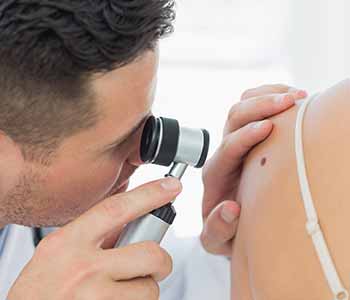Non-invasive, image-guided superficial radiation therapy treats non-melanoma skin cancers in Algonquin, IL patients
Posted by Dr. Vikram Khanna
What is image-guided superficial radiation therapy?
Image-guided superficial radiation therapy is a non-surgical form of skin cancer treatment that destroys non-melanoma cancer cells without the need for excision. With IGSRT, patients can enjoy a successful treatment without the downtime or side effects associated with surgery. Patients love that IGSRT therapy can be used on cosmetically sensitive areas like the eyelids, nose, and ears without the fear of surgical scarring. At our office, we use the SRT-100™.What is Non-Melanoma Skin Cancer?
Of the three main types of skin cancer, two are non-melanoma: squamous cell and basal cell. Basal cells are located in the base layer of the skin.Basal cell cancers are typically slow growing and rarely spread beyond their initial location, although they can expand wide and deep, making it a potentially disfiguring cancer.
Squamous cells makeup most of the outer layer of skin. Squamous cell carcinoma is less common than basal cell carcinoma, however this type of cancer is more likely to grow and spread.
IGSRT Treatment in Algonquin
The SRT-100 uses low-dose radiation to destroy non-melanoma skin cancer cells and keloid-forming tumor cells. The superficial radiation penetrates only five millimeters into the skin, leaving healthy tissue unharmed.Patients who have a positively confirmed non-melanoma skin cancer will begin with a consultation to determine if IGSRT therapy is the best option. Determining if a patient is a suitable candidate for IGSRT therapy depends on the location, size, type, and stage of the cancer.
One IGSRT session takes only a few minutes to complete after the patient has been prepared. The highly specialized device is calibrated to only deliver the radiation therapy where it’s needed and to leave healthy tissue intact. Most non-melanoma cancers require anywhere between 8 and 15 treatment sessions.
Unlike surgical treatments, there is no downtime or recovery after IGSRT therapy. There is also less risk of scarring and infection with radiation therapy.
Is image-guided superficial radiation therapy safe and effective?
IGSRT therapy is effective on non-melanoma skin cancers because they tend to be localized and slower to spread than melanoma. In fact, IGSRT therapy is often considered equally effective as a Mohs excision and even more effective than a non-Mohs excision.The SRT-100 device was designed specifically to treat skin cancer and differs from radiation therapy for internal malignant tumors. Since the radiation only needs to penetrate just below the skin surface, it uses a fraction of the energy of traditional radiation, making it very safe.
Side effects from IGSRT treatment
 There are very few side effects from image-guided superficial radiation therapy. Usually after three to four treatments, patients may notice that the skin becomes pink and might be slightly scaly or crusty. Rarely, a wound or ulcer may form temporarily at the treatment site. If the area is painful, patients should report that immediately to Dr. Khanna. If the skin cancer is located near the scalp, patients may experience some localized hair loss.
There are very few side effects from image-guided superficial radiation therapy. Usually after three to four treatments, patients may notice that the skin becomes pink and might be slightly scaly or crusty. Rarely, a wound or ulcer may form temporarily at the treatment site. If the area is painful, patients should report that immediately to Dr. Khanna. If the skin cancer is located near the scalp, patients may experience some localized hair loss.
After treatment, the pinkness will fade back to normal skin color with minimal to no scarring. In the years following treatment, some patients may experience a lightening of the skin on the treated area.
Benefits of IGSRT therapy
- No cutting
- No stitching
- Minimal to no scarring
- Multiple cancers can be treated at once
- No downtime
Featured Articles
- Dermatologist in Algonquin, IL describes the benefits of blue light phototherapy
- Dermatologist in Algonquin, IL describes how to get rid of chapped lips
- Algonquin, IL dermatologist offers tips for dry skin relief during the winter months
- Patients in Algonquin ask, “Does Xtrac Laser therapy work for psoriasis?”
- Patients in Algonquin seek information on the costs and benefits of image-guided superficial radiation therapy for skin cancer
- What are the benefits of Xtrac laser treatment for patients in Algonquin, IL?
- Blue light therapy can be used in Algonquin, IL to effectively treat acne
- Non-invasive, image-guided superficial radiation therapy treats non-melanoma skin cancers in Algonquin, IL patients
- Patients in Algonquin get clearer skin with the help of Xtrac laser treatments





















